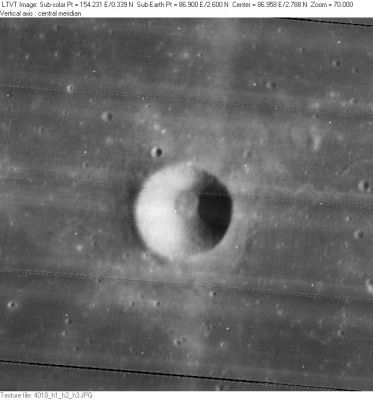Peek
Contents
Peek - at the northern section of Mare Smythii
|
Lat: 2.75°N, Long: 86.93°E, Diam: 12.55 km, Depth: 2.34 km, Rükl 38 |
Images
LPOD Photo Gallery Lunar Orbiter Images Apollo Images
Gallery of orbital Apollo (and Lunar Orbiter) photographs which show crater Peek and its environs:
- AS17-149-22843 shows Peek' at the image's right margin, and the approaching Ascent Stage (AS) of Apollo 17's LM Challenger near the silhouette of CM Americas window.
- Apollo 11's AS11-43-6471 shows an oblique east-looking view at crater Schubert C (in the foreground; the LTO's "Doyle"), Peek a little leftward of the frame's centre, and the LTO's "Pirandello" eastward of Peek.
- Peek is also visible on the first ten images of Lunar Orbiter I (starting with Frame 1006, which is the second image made by L.O. I). Frame 1011 is one of those images.
- A magnificent close up of the bowl-shaped crater Peek is noticeable in Apollo 16's orbital ITEK-panoramic frame AS16-P-5100. Scroll to the right, Peek is located a bit beyond the frame's centre.
- High sun at Peek, note the small dark spots on Peek's inner slopes. Scroll to the right, about "halfway" of Apollo 15's orbital ITEK-panoramic frame AS15-P-9110.
- Oblique northward looks at Peek are noticeable near the right margins of Apollo 16's orbital ITEK-panoramic frames AS16-P-4348 and AS16-P-4355.
- Oblique southward looks at Peek are noticeable near the left margins of Apollo 17's orbital ITEK-panoramic frames AS17-P-2579 and AS17-P-2584.
- Additional research Lunar Orbiter and Apollo photographs: Danny Caes
Maps
Description
Peek is a classic simple crater, lacking terraces and possessing only a few tiny hills that could be precursors of the central peaks that develop in larger craters. It is superposed on Mare Smythii lavas but does not possess significant bright ejecta so has been eroded somewhat. Based on crater counts the mare is 1-2 b.y. old, one of the youngest surfaces on the Moon, and hence a target for future sample collecting.
Wikipedia
Additional Information
- IAU page: Peek
- Depth data from Kurt Fisher database
- Pike, 1976: 2.34 km
- From the shadows in LO-IV-018H, Peek is 2030-2040 m deep. - Jim Mosher
- East-northeast of Peek, at 4° North/ 89° East (between Peek and Nunn) is a craterlet with remarkable bright "star"-shaped ejectablanket, which could be an interesting target for today's observers and photographers of the moon's eastern limb. This little bright spot was photographed during the missions of Apollo 10 (AS10-33-4886, AS10-34-5081), Apollo 11 (AS11-42-6295 + 6296, AS11-43-6452), and Apollo 17 (AS17-P-2573, 2578, 2580, 9108). - DannyCaes Jan 12, 2008
- Peek Crater: Potential Future Lunar Landing Site (Lunar Image of the Week, 4/15/2008, Arizona State University).
Nomenclature
- Named for Bertrand Meigh Peek (1891-1965), a British observer who studied Jupiter.
- This name appears on LTO-63C3 (for which it served as the chart title). The map does not indicate if it replaces a previous name, but it does not appear to do so. Although it appears in the cumulative list of approved names in IAU Transactions XVB, it is not clear precisely when and where it was approved. Biographical information was unofficially reported in Ashbrook, 1974. - Jim Mosher
- Let's assume it (the name Peek) is near the moon's eastern libration zone (the eastern limb) because of the angular proximity of the (to-be-occulted) planet Jupiter (Jupiter was B.M.Peek's favourite telescopic target). - DannyCaes Dec 14, 2014
- East of Peek, also in Mare Smythii, is an incomplete crater which is called Pirandello on LTO-63C3. Who was Pirandello? See this Wikipedia-page. - DannyCaes Mar 27, 2008
LPOD Articles
Bibliography
B. M. Peek in the Sourcebook Project (William R. Corliss)
B. M. Peek is frequently mentioned in Chapter 10 (Jupiter) of the book Mysterious Universe, a handbook of astronomical anomalies (1979) :
- Page 436: Rapidly Moving Spots on the Planet Jupiter (Nature, 1939) (anonymous)
- Page 436: Disturbances on Jupiter (Nature, 1928) (anonymous)
- Page 438: Sudden Changes in the Motion of Jupiter's Great Red Spot during 1962 (Monthly Notices of the Royal Astronomical Society, 1966)
- Page 438: Correlation between Solar Activity and the Brightness of Jupiter's Great Red Spot (E.R.Graf, Nature, 1968)
- Page 440: Relation between the Visibility of Jupiter's Red Spot and Solar Activity (D.Basu, Nature, 1969)
- Page 457: The Doubling of Jovian Satellite Shadows (Richard E. Wend, Strolling Astronomer, 1965)
Saturn related:
- Page 489: Extended Glow Preceding Reappearance of Saturn during a Lunar Occultation (G.Reed, Nature, 1974)
Certain books...
John A. Keel's Our Haunted Planet (1971) mentions B.M.Peek's thinking about Jupiter's GRS (Great Red Spot) (according to Peek, the GRS is some sort of giant expanse of water, drifting like an iceberg in the Jovian ocean).
WARNING:
Those who are adrift in second-hand bookstores might discover John A. Keel's Our Haunted Planet. So far so good, but they should be aware of the abominable disrupting influence of that book. The writer of this piece of text is also a victim of it, he doesn't want to believe the schoolish perception of mankind's prehistory anymore... (call it the Von Daniken effect, aka The-Egyptian-Pyramids-Are-Too-Big syndrome).
- DannyCaes Sep 12, 2015
Named Featues -- Prev: Pease -- Next: Peirce
